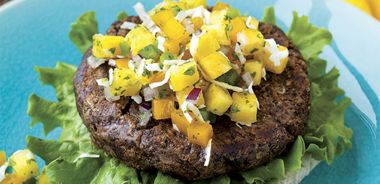Black Lentil Burgers with Pineapple Salsa

The vibrant yellow salsa with a sweet kick from pineapple is a fetching contrast to the fibre-packed lentil burgers. More common green lentils can be substituted for the black ones, but they tend to produce moister burgers so you may need to add some additional wheat germ to offset this. Uncooked burgers can be made up to three days in advance and cooked as needed.
1 cup (250 mL) black beluga lentils, rinsed
1 1/2 cups (325 mL) finely diced pineapple
1 yellow bell pepper, finely diced
1/2 cup (125 mL) finely diced red onion
1/3 cup (80 mL) fresh chopped cilantro
1 jalapeno pepper, seeded and minced
3 Tbsp (45 mL) dried unsweetened coconut
Zest of 1 lime
Juice of 1/2 lime
1/2 cup (125 mL) wheat germ
1/2 cup (125 mL) grated Parmesan cheese
1/3 cup (80 mL) flat-leaf parsley
1 large free-range egg
2 garlic cloves, minced
2 Tbsp (30 mL) balsamic vinegar
1 Tbsp (15 mL) Dijon mustard
1/2 tsp (2 mL) cumin powder
Juice of 1/2 lemon
1/4 tsp (1 mL) freshly ground black pepper
1/3 cup (80 mL) chopped walnuts
2/3 cup (160 mL) pitted kalamata olives, finely chopped
1 Tbsp (15 mL) grapeseed oil, for frying
Place lentils and 2 1/2 cups (625 mL) water in medium saucepan, bring to a boil, and simmer until lentils are tender, about 20 minutes. Drain and let cool slightly.
Meanwhile, make salsa by combining pineapple, yellow pepper, onion, cilantro, jalapeno, coconut, lime zest, and lime juice in large bowl.
Add 1 1/2 cups (350 mL) of cooked lentils to food processor along with wheat germ, Parmesan, parsley, egg, garlic, balsamic vinegar, mustard, cumin, lemon juice, and black pepper. Blend until mixture is only slightly grainy. Add remaining lentils, walnuts, and olives and pulse until they are incorporated into mixture. Form into 8 equal-sized patties, about 1 in (2.5 cm) thick.
Cook patties, in batches if necessary, in frying pan over medium heat with oil for 3 minutes per side. Or prepare burgers in a 350 F (180 C) oven for 10 minutes, flipping halfway through baking time. Overcooking will result in dry burgers, so cook them just until browned on the outside but still slightly moist.
Serve lentil burgers topped with salsa.
Serves 4.
Each serving contains: 471 calories; 26 g protein; 18 g total fat (6 g sat. fat, 0 g trans fat); 58 g total carbohydrates (9 g sugars, 15 g fibre); 447 mg sodium
source: "Colour Your Plate", alive #367, May 2013





